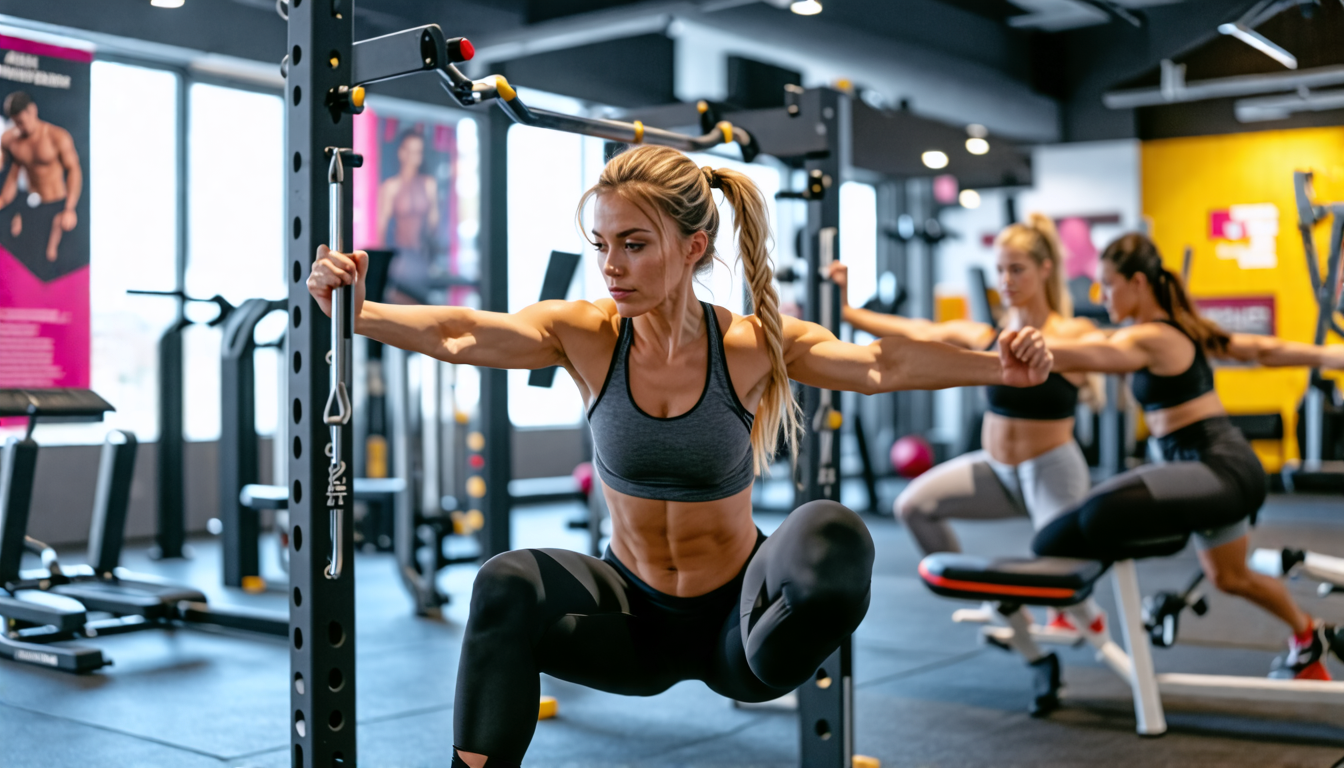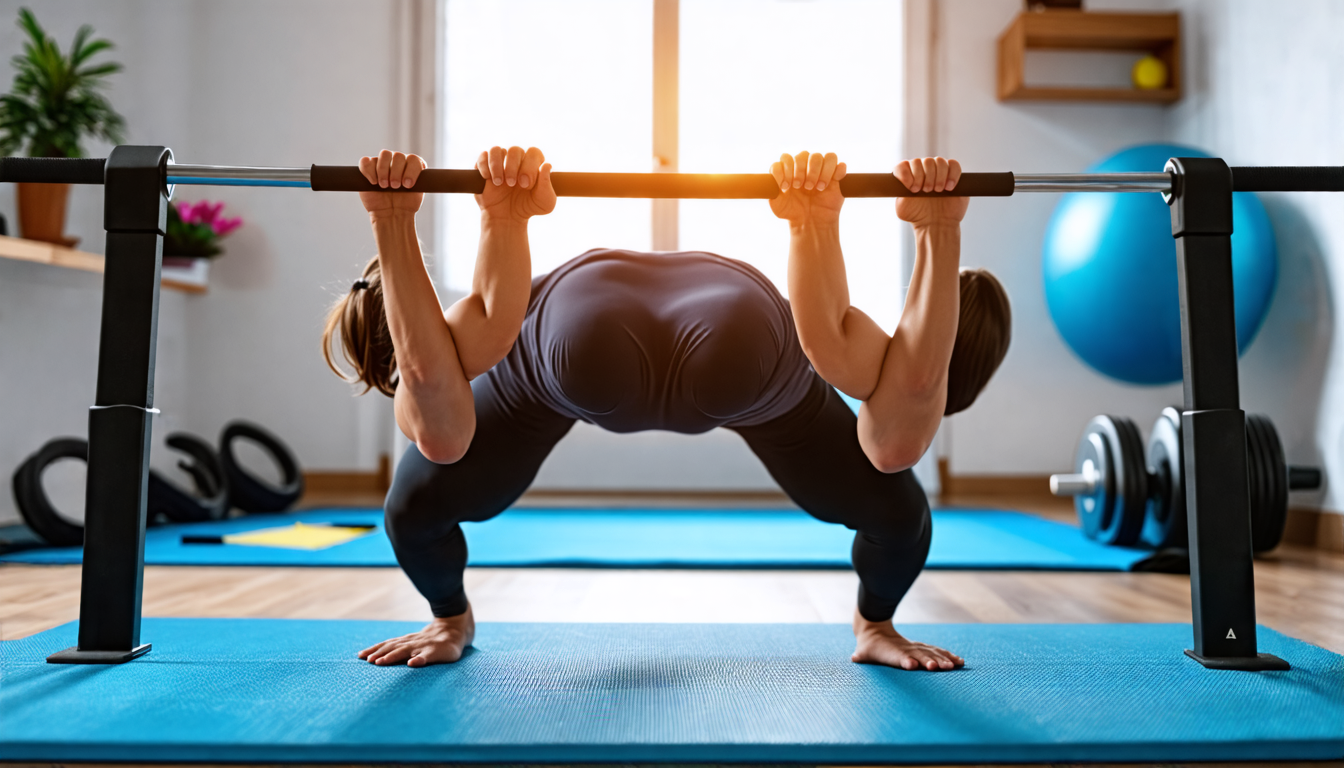In an era where home fitness solutions are gaining immense popularity, the fitness bar stands out as a versatile and effective tool, especially for those looking to enhance their core strength. Use of a fitness bar not only helps in targeting the central muscles of your body but also promotes overall stability and balance, which is crucial for everyday activities and overall fitness. Whether you’re a seasoned athlete or a fitness enthusiast setting up a home gym, integrating a fitness bar into your routine can be transformative. Core muscles, comprising the abdominals, obliques, and lower back muscles, play a pivotal role in maintaining good posture, preventing injuries, and improving athletic performance. Engaging these muscles with specific bar exercises can lead to a stronger, more resilient core.
This article delves into how you can effectively use a fitness bar to fortify your core muscles, detailing a variety of exercises along with step-by-step guides. Additionally, we will offer essential tips on maintaining proper form and technique to help you attain the best results while minimizing the risk of injury. Embrace the journey towards a stronger core with the fitness bar — your key to enhanced fitness and better functional movement in daily life.
Introduction to Fitness Bars for Core Strengthening
Welcome to the world of fitness bars, a versatile and essential tool for anyone looking to build a stronger core. Fitness bars come in various types and designs, from simple pull-up bars to sophisticated multifunctional stations. These humble yet effective tools can significantly impact your core training routine.
One of the standout benefits of fitness bars is their ability to engage multiple muscle groups simultaneously. Unlike isolation exercises that target a single muscle, fitness bar workouts usually require a combination of movements. This approach not only enhances your core strength but also boosts overall body stability and coordination. Whether you’re doing pull-ups, hanging leg raises, or advanced gymnastic moves, the fitness bar can be your go-to equipment for a comprehensive core workout.
Our core muscles are more than just the coveted six-pack abs. The core includes a wide array of muscles in the front, sides, and back of your torso. These muscles are crucial for stability, balance, and power. They serve as the foundation for nearly every physical activity. Here’s a deeper look into why core strength is vital:
Importance of Core Muscles in Overall Fitness and Daily Activities
The core muscles, including the rectus abdominis, obliques, and transverse abdominis, extend well beyond the surface level. They work synergistically to support your spine, maintain posture, and allow for a graceful range of motion. Let’s delve into some of the reasons why strengthening these muscles should be a priority:
- Enhanced Functional Movement: A strong core is essential for everyday activities like bending, lifting, and twisting. Tasks such as reaching for something on a high shelf or carrying groceries become easier and safer.
- Improved Athletic Performance: Whether you are a runner, swimmer, or weightlifter, a robust core enhances your performance by providing better balance and stability. It allows for more efficient movements, thereby improving speed and endurance.
- Injury Prevention: A well-developed core helps protect against injuries, especially in the lower back. It acts as a stabilizing force, reducing the risk of strains and sprains during physical activities.
- Better Posture: Core strength supports a healthy posture, reducing the likelihood of developing postural imbalances. Good posture not only looks better but also minimizes stress on the spine and shoulders, preventing chronic pain.
- Pain Reduction: For individuals suffering from chronic lower back pain, strengthening the core muscles can provide significant relief. These muscles help take the load off the spine, distributing weight more evenly and reducing strain.
- Improved Breathing: The muscles involved in core strength also play a role in breathing. A strong core can enhance the efficiency of your respiratory system, leading to better oxygenation and overall cardiovascular health.
Using a fitness bar to target your core provides a diverse range of exercises that can be adapted to any fitness level. By incorporating a fitness bar into your routine, you’re opting for a tool that can challenge you in multiple ways. For instance, exercises like hanging windshield wipers or toes-to-bar offer dynamic challenges that you won’t get from traditional floor exercises.
Additionally, fitness bars are incredibly user-friendly and accessible for home use. They take up minimal space and can often be installed in doorframes or mounted on walls, making them a perfect addition to your home fitness setup. The versatility of a fitness bar allows you to perform a plethora of core-strengthening exercises without the need for bulky equipment.
If you are new to using a fitness bar or core training in general, it’s essential to start with beginner-friendly exercises and progressively increase the complexity as your strength and confidence grow. With proper guidance and technique, you can safely and effectively use a fitness bar to elevate your core strength.

Effective Fitness Bar Exercises to Strengthen Your Core
Using a fitness bar can be an incredibly effective way to target and strengthen your core muscles. Here are some highly effective exercises that you can perform using a fitness bar, along with detailed instructions to ensure you get the most out of your workouts while avoiding injury.
1. Overhead Squats
The overhead squat is a powerful compound exercise that engages the entire core, particularly the lower back, abdominals, and obliques.
- Instructions:
- Stand with your feet shoulder-width apart, holding the fitness bar with an overhand grip above your head.
- Engage your core and slowly lower into a squat position by bending at the hips and knees.
- Keep the bar steady overhead and ensure your back remains straight throughout the movement.
- Pause briefly at the bottom of the squat, then push through your heels to return to the standing position.
- Tips:
- Maintain a tight core and straight back to avoid injury.
- Make sure your knees don’t extend past your toes while squatting.
- Use a mirror to check your form if you’re unsure.
2. Russian Twists
Russian twists target the obliques and help improve overall core stability.
- Instructions:
- Sit on the floor with your knees bent, feet flat, and hold the fitness bar horizontally in front of you with both hands.
- Lean back slightly, keeping your spine straight and core engaged.
- Twist your torso to the right, bringing the fitness bar beside your right hip.
- Return to the center position, and then twist to the left.
- Repeat this motion in a controlled manner.
- Tips:
- Move slowly to maintain control and maximize muscle engagement.
- Keep your feet flat on the ground or elevate them slightly for an added challenge.
- Remember to breathe steadily throughout the exercise.
3. Plank Rows
The plank row is an excellent exercise for enhancing core strength while also engaging the upper body, particularly the back muscles.
- Instructions:
- Assume a high plank position with your hands holding the fitness bar shoulder-width apart.
- Engage your core and keep your body in a straight line from head to heels.
- Row the fitness bar towards your ribcage with one hand while balancing on the other.
- Lower the bar back to the ground and repeat with the opposite hand.
- Alternate sides for the desired number of repetitions.
- Tips:
- Keep your hips level throughout the exercise to avoid twisting your torso.
- Engage your glutes and thigh muscles for additional stability.
- Use a pair of lighter fitness bars initially if balancing is challenging.
4. Standing Overhead Press
While primarily an upper body exercise, the standing overhead press also requires substantial core engagement to maintain stability and proper form.
- Instructions:
- Stand with your feet hip-width apart and hold the fitness bar at shoulder height with both hands.
- Engage your core and press the bar overhead until your arms are fully extended.
- Pause briefly at the top, then slowly lower the bar back to shoulder height.
- Repeat for the desired number of repetitions.
- Tips:
- Avoid arching your back by keeping your core tight.
- Make sure to press the bar in a straight line upward, not forward or backward.
- Start with a lighter weight and gradually increase as your strength improves.
5. Landmine Twists
Landmine twists are excellent for developing rotational strength and stability in your core.
- Instructions:
- Secure one end of the fitness bar into a landmine attachment or corner.
- Stand with feet shoulder-width apart, holding the other end of the bar with both hands at chest height.
- Rotate your torso to swing the bar down towards your right hip, pivoting on your back foot.
- Return to the starting position and repeat on the opposite side.
- Continue alternating sides for the desired number of repetitions.
- Tips:
- Focus on a slow and controlled movement to fully engage your core.
- Keep your arms slightly bent to reduce strain on your shoulders.
- Ensure your movements are coming from your torso, not just your arms.
Incorporating these fitness bar exercises into your routine can significantly enhance your core strength. Remember to start with lighter weights and focus on maintaining proper form to avoid injury. With consistency and dedication, you’ll see substantial improvements in your core stability and overall fitness levels.
Using a fitness bar to strengthen your core is an effective and versatile approach to enhancing your overall fitness. The benefits of incorporating a fitness bar into your workout routine are numerous; it not only targets the core muscles essential for stability and balance but also improves your posture and supports better performance in daily activities and other exercises. The core muscles, which include the abdominals, obliques, lower back, and hips, are foundational to a strong, healthy body and are crucial for everything from sitting and standing to lifting and twisting.
Effective fitness bar exercises such as standing twists, overhead presses with a twist, and seated Russian twists provide comprehensive core engagement. These exercises, when performed with proper form and technique, maximize the activation of core muscles while minimizing the risk of injury. Remember to start with a lighter bar and progressively increase the resistance as your strength improves. Paying attention to your form is critical; engage your core, maintain a neutral spine, and execute controlled movements.
In conclusion, a fitness bar can be one of the most potent tools in your home fitness arsenal for building core strength. Its versatility allows for a wide range of exercises that can be tailored to different fitness levels. By integrating fitness bar exercises into your routine and following the step-by-step guides we’ve provided, you can effectively strengthen your core. This dedication to core training will yield significant benefits, not only improving your physique and physical performance but also enhancing your overall well-being and functionality in everyday life.

